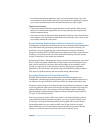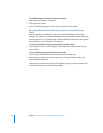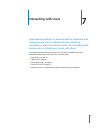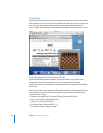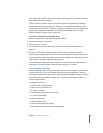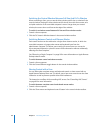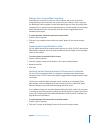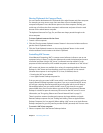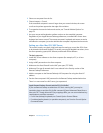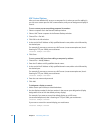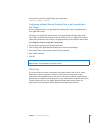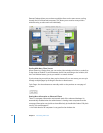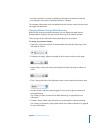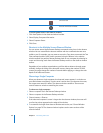
Chapter 7 Interacting with Users 83
2 Select one computer from the list.
3 Choose Interact > Control.
If the controlled computer’s screen is larger than your control window, the screen
scrolls as the pointer approaches the edge of the window.
4 To customize the control window and session, see “Control Window Options” on
page 79.
5 Use your mouse and keyboard to perform actions on the controlled computer.
Regardless of your Apple Remote Desktop preferences, controlled VNC servers share
keyboard and mouse control. The remote computer’s keyboard and mouse are active
and affect the computer just as the administrator computer’s keyboard and mouse do.
Setting up a Non–Mac OS X VNC Server
This section contains very basic, high-level steps for setting up a non–Mac OS X client
to be viewed with Remote Desktop. This section cannot give detailed instructions, since
the client operating system, VNC software, and firewall will be different.
The basic steps are:
1 Install VNC Server software on the client computer (for example, a PC, or a Linux
computer).
2 Assign a VNC password on the client computer.
3 Make sure the client’s firewall has the VNC port open (TCP 5900).
4 Make sure “Encrypt all network data” is not selected in the Security section of the
Remote Desktop Preferences.
5 Add the computer to the Remote Desktop’s All Computers list using the client’s IP
address.
6 Put the client computer’s VNC password in the Remote Desktop authentication box.
There is no user name for a VNC server, just a password.
Apple Remote Desktop Control and the PC’s Ctrl-Alt-Del
If you use Remote Desktop to administer a PC that’s running VNC, you may be
wondering how to send the Ctrl-Alt-Del command (Control-Alternate-Delete) from a
Mac to the PC. Though Mac and PC key mappings differ, you can use an alternate key
combination to send the command.
 For full-size (desktop) keyboards, use Control-Option-Forward Delete.
 For abbreviated keyboards (on portable computers), use Function-Control-Option-
Command-Delete.



